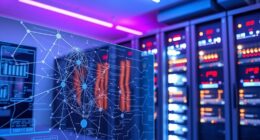As AI enthusiasts, we were like kids in a candy store at the recent hackathon in San Francisco, where top engineers showcased their cutting-edge AI agents.
From autonomous vehicle testing to real-time event monitoring and interactive experiences, the competition was fierce.
Driven by the power of neural networks, these agents pushed the boundaries of AI decision making.
Join us as we delve into the world of AI engineering and gain insights from the experts who participated in this groundbreaking event.

Innovation awaits!
Key Takeaways
- Engineers from around the world gathered in San Francisco to showcase state-of-the-art AI agents in a hackathon.
- The finalists included Auto Arena, Stim, Engagement Farmers, Spin-up, and Language Models Represent Space and Time paper.
- Dr. Jim Fan, a senior AI scientist at Nvidia, was involved in the development of the Minecraft Voyager AI model.
- There was a debate on the power and capabilities of neural networks in AI agent decision making.
Global Gathering of AI Engineers
We gathered engineers from around the world in San Francisco for the AI Engineers Competition.
This global gathering of AI engineers showcased the cutting-edge innovations and emerging AI trends in the global AI community.
The competition served as a platform for these engineers to showcase their expertise and push the boundaries of AI technology.

The event brought together top talent from various countries, fostering collaboration and knowledge-sharing among participants.
It was an opportunity to witness the latest advancements in AI and witness the potential for groundbreaking applications.
As we observed the presentations and demonstrations, it became evident that the global AI community is at the forefront of driving innovation and shaping the future of AI technology.
The competition highlighted the immense talent and dedication present in the AI engineering field, setting the stage for continued advancements and breakthroughs in the coming years.

State-of-the-Art AI Agents Compete
State-of-the-art AI agents competed in the SF Hackathon, showcasing their cutting-edge capabilities and pushing the boundaries of AI technology. These agents leveraged the latest neural network advancements to achieve remarkable feats in real-time event monitoring.
Here are four highlights from the competition:
- Auto Arena: Developed autonomous AI agents for rigorous testing.
- Stim: Created an AI agent specializing in real-time event monitoring.
- Engagement Farmers: Designed an AI agent that emulates Reddit-like interaction.
- Spin-up: Built an AI agent capable of generating comments.
These agents demonstrated the power of neural networks in analyzing and responding to complex events in real time.
The competition not only fostered innovation but also shed light on the exciting possibilities of AI in various domains, including autonomous systems, social media, and content generation.

Finalists and Their Innovative Agents
The finalists in the SF Hackathon showcased their innovative AI agents, pushing the boundaries of AI technology. These agents have the potential to greatly impact society and raise important ethical considerations in AI decision-making.
The Auto Arena team presented their autonomous AI agents, demonstrating the potential for self-driving cars to navigate complex road scenarios.
Stim showcased real-time event monitoring agents that can detect and respond to emergencies and critical situations.
Engagement Farmers presented AI agents capable of facilitating Reddit-like interactions, enabling users to engage in meaningful discussions and share relevant content.

Spin-up showcased agents that can generate comments, providing valuable insights and promoting engagement in online platforms.
Finally, the Language Models Represent Space and Time paper introduced agents with advanced language processing capabilities, opening up new possibilities for natural language understanding and communication.
These innovative agents have the potential to revolutionize various industries and society as a whole, but it’s crucial to consider the ethical implications of their decision-making processes.
Dr. Jim Fan’s Involvement in Minecraft Voyager
Dr. Jim Fan played a key role in developing the Minecraft Voyager AI model at the SF Hackathon. His involvement in this project brought valuable insights and expertise to the team.

Here are some notable aspects of his contribution:
- Dr. Jim Fan’s expertise: With his extensive knowledge in AI and deep learning, Dr. Fan provided valuable guidance and technical expertise throughout the development of the Minecraft Voyager AI model.
- Counterfactual reasoning: Dr. Fan’s contribution included implementing counterfactual reasoning techniques into the AI decision-making process. This approach allows the AI agent to consider alternative scenarios and make more informed decisions.
- Enhancing decision-making capabilities: Dr. Fan’s involvement focused on optimizing the AI model’s decision-making abilities by incorporating counterfactual reasoning. This approach enables the AI agent to anticipate and evaluate the potential outcomes of different actions.
- Advancing AI in gaming: Through his work on Minecraft Voyager, Dr. Fan contributed to the advancement of AI in gaming. The integration of counterfactual reasoning techniques in this AI model opens up new possibilities for intelligent and adaptive gameplay.
Exploring the Concept of World Models
During the SF Hackathon, we delved into the concept of world models, exploring their role in AI agent decision making.
World models serve as a core component in enabling AI agents to make informed decisions by predicting consequences, reasoning, planning, exploring, and avoiding mistakes.
These models have various applications in real-world scenarios, allowing AI agents to learn new skills and adapt to different environments.

However, the development of AI agents with world models also raises ethical considerations. The potential impact of these agents on society, privacy, and human autonomy must be carefully examined and regulated.
Striking a balance between innovation and responsible development is crucial to ensure the ethical deployment of AI agents with world models in the future.
AI Agents and Decision-Making Strategies
As we delve into AI Agents and their decision-making strategies, it’s important to consider the role of world models in guiding their actions and choices. World models serve as a core concept in AI agent decision making, enabling them to predict consequences, reason, plan, explore, and avoid mistakes.
In order to enhance decision-making capabilities, causal learning and active intervention are crucial. These strategies allow AI agents to understand cause-and-effect relationships and actively intervene in their environment to achieve desired outcomes. By incorporating causal learning, AI agents can make more informed decisions based on understanding the underlying factors influencing a situation.

Active intervention empowers AI agents to take deliberate actions to shape their environment and optimize decision-making processes. Together, these approaches enable AI agents to make smarter, more effective choices in a wide range of scenarios.
Insights From AI Experts’ Perspectives
Building upon our understanding of AI Agents and their decision-making strategies, let’s delve into the insights provided by AI experts’ perspectives.
In the realm of AI, causal learning and simulation play vital roles in the development of intelligent agents. By understanding the cause-and-effect relationships in their environment, AI agents can make more informed decisions and simulate potential outcomes.
Additionally, language models possess internal world models that enable them to comprehend and generate coherent text. These world models allow language models to understand context, make predictions, and generate responses that align with human-like understanding.

AI experts have highlighted the importance of incorporating causal learning, simulation, and language models’ internal world models into the decision-making processes of AI agents to enhance their capabilities and achieve more sophisticated and human-like performance.
Showcasing AI Models With World Modeling Capabilities
We showcased AI models with world modeling capabilities at the SF Hackathon. These models have the ability to predict consequences, reason, plan, explore, and avoid mistakes, making them highly valuable in decision-making processes.
Here are four key points about these AI models:
- Ethical implications: The use of world modeling in AI raises important ethical considerations. As these models become more sophisticated, it’s crucial to ensure that they’re used responsibly and in a manner that aligns with societal values.
- Applications in real-world scenarios: The applications of AI models with world modeling capabilities are vast. They can be used in various industries, such as healthcare, finance, and transportation, to make informed decisions, optimize processes, and improve outcomes.
- Improved decision-making: By incorporating world models into AI agents, decision-making processes can be enhanced. These models provide a deep understanding of the environment, enabling agents to make more accurate predictions and take optimal actions.
- Advancements in AI research: The development and demonstration of AI models with world modeling capabilities signify significant advancements in AI research. These models push the boundaries of what AI systems can achieve and pave the way for new innovations in the field.
Counterfactual Reasoning in AI Decision Making
Our exploration of AI models with world modeling capabilities continues as we delve into the realm of counterfactual reasoning in AI decision making.

Counterfactual reasoning refers to the ability of AI agents to reason about hypothetical scenarios and their potential outcomes, even if they haven’t occurred in reality. This capability allows AI agents to make informed decisions by considering alternative possibilities and their implications.
However, counterfactual reasoning in AI decision making also presents ethical implications, as it raises questions about the responsibility and accountability of AI agents in hypothetical scenarios. Furthermore, there are limitations and challenges in implementing counterfactual reasoning, such as the difficulty of accurately predicting the consequences of hypothetical actions and the potential biases that may arise.
Addressing these challenges is crucial to ensure the ethical and reliable use of counterfactual reasoning in AI decision making.
Predictions From AI Insider, Jimmy Apples
According to an AI insider, Jimmy Apples, the predictions for the future of AI include groundbreaking advancements in the field. Our analysis of Jimmy Apples’ predictions reveals several key insights:

- Counterfactual Reasoning: Jimmy Apples predicts that AI will make significant progress in counterfactual reasoning, enabling machines to simulate alternative scenarios and make more informed decisions.
- GPT 4 Announcement Date: Jimmy Apples claims to have insider knowledge about the exact date of the GPT 4 announcement, suggesting that this highly anticipated release will occur in the near future.
- Enhanced Natural Language Processing: Apples foresees major advancements in natural language processing, enabling AI systems to better understand and generate human-like text.
- Increased Automation: Apples predicts that AI will continue to drive automation across various industries, revolutionizing processes and enhancing productivity.
These predictions from Jimmy Apples offer a glimpse into the exciting future of AI, where machines will possess advanced reasoning capabilities, revolutionize language processing, and drive automation to new heights.
Conclusion
The showcase of cutting-edge AI agents at the SF hackathon was an awe-inspiring affair, with engineers from around the globe gathering to push the boundaries of artificial intelligence.
The diverse range of finalists displayed their innovative agents, demonstrating the power and capabilities of neural networks.
Dr. Jim Fan’s involvement in the Minecraft Voyager AI model added another layer of excitement to the event.

Through world modeling and counterfactual reasoning, these agents showcased their ability to make precise and analytical decisions.
The future of AI engineering looks promising with such advancements on display.











